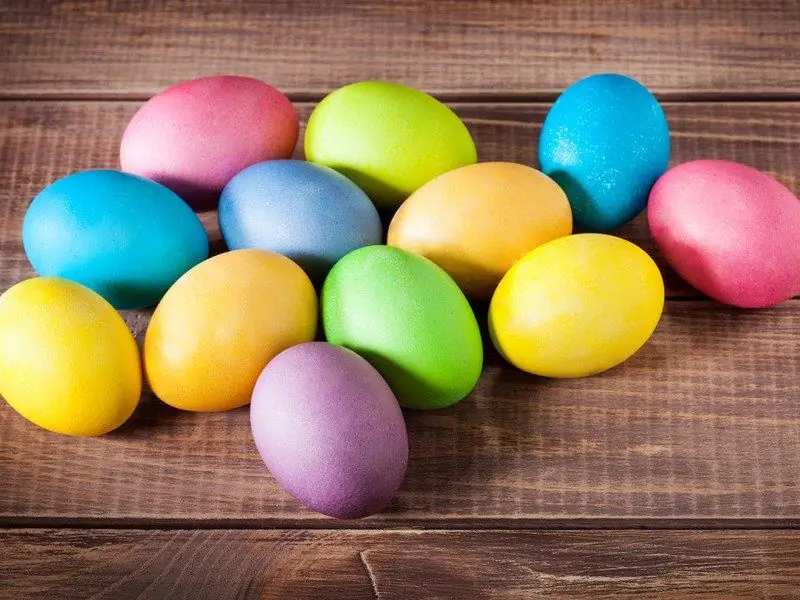
Table of contents:
- Author Bailey Albertson [email protected].
- Public 2024-01-17 22:26.
- Last modified 2025-06-01 07:32.
Red, blue, marble: we paint eggs for Easter without industrial dyes

Before Easter, all kinds of dyes and iron-on stickers for eggs appear in stores. The film interferes with peeling the egg, and the quality of the store paint is in doubt? It doesn't matter, let's look at the safe egg decorating options that our grandmothers used.
Content
-
1 Ways to decorate eggs for Easter
- 1.1 Beet coloring
- 1.2 Staining with red cabbage
-
1.3 Onion hulls for coloring eggs
1.3.1 Video: Staining eggs with turmeric, beetroot and red cabbage
- 1.4 Marble staining options
-
1.5 Decorations with patterns
1.5.1 Photo gallery: beautiful options for unusual coloring of Easter eggs
Ways to decorate eggs for Easter
Before you start coloring eggs, you need to boil them properly. So that the shell does not crack, and the paint lies in an even layer, wash the eggs well and let them lie for 2 hours at room temperature. Adding a tablespoon of salt to 2 liters of water helps prevent protein flowing out of cracks during cooking.

You can paint eggs with white or brown shells, but on a light basis, the colors are brighter
To prevent the skin of your hands and nails from taking on the color of the paint, you need to carry out staining with disposable gloves from a pharmacy or hardware store. The color will take better if you first grease the egg with a 9% vinegar solution or add it to the coloring solution. Keep in mind that dishes will stain too and can be difficult to clean. It is advisable to take pots that you do not mind.
Beet coloring
There are several ways to add color to the eggshell with beets:
-
grate the raw root vegetable peeled from the skin and cover the already boiled eggs with the resulting mass. The intensity of the shade depends on the duration of the staining;

Grated beets in a bowl The size of the grated beet does not play a big role, you can also use a coarse grater, since the eggs will be immersed in it
-
squeeze the juice from the grated beets, add 2-3 tbsp. tablespoons of vinegar (9%). Pour boiled eggs in a container with beet juice so that they are completely covered with the coloring liquid. After 3 hours, the eggshell will turn pink, and the eggs left overnight will acquire the burgundy color of a beet;

Pale pink eggs lie on the table Beet juice, with a short staining, gives the eggs a soft pink, closer to coral, color
-
place grated beet pulp in boiling water at the rate of one whole root vegetable per liter of water. Simmer for 10-12 minutes, then remove the pulp with a slotted spoon and pour 3 tbsp. tablespoons of vinegar. Dip the boiled eggs in the beetroot broth and leave overnight.

Three burgundy eggs on a decorative pillow After a night spent in beetroot broth, eggs turn burgundy
Red cabbage staining
Despite the name, red cabbage dyes eggs blue. Cabbage broth helps to do this:
- Finely chop the head of cabbage - 700-800 g - and place in a saucepan.
- Pour boiling water over chopped cabbage - 1 liter - and set to cook for half an hour.
- Pour the cooled broth into another container and add 2-3 tbsp. tablespoons of vinegar.
- Dip boiled eggs in cabbage broth so that they are completely immersed in the colored liquid.
-
Leave the eggs to stain for 3-5 hours, preferably overnight for greater color intensity.

Eggs and container with red cabbage Red cabbage actually has a purple hue, which is given to it by the blue pigment anthocyanin - such a confusing story.
Instead of broth, you can use diluted red cabbage juice. It is better to cook it in the evening:
- Slice medium-sized red cabbage.
- Add 6 tbsp. tablespoons of vinegar and 0.5 liters of water.
- Refrigerate until morning, during which time the cabbage will give juice.
-
Pour the infusion into a convenient container and immerse the boiled eggs, adjusting the shade intensity as desired.

Three blue eggs lie in a green onion Red cabbage staining gives the eggshell a prettier shade of blue than industrial dyes
Onion peels for coloring eggs
It is better to stock up on onion husks in advance, you will need a lot of it - a tightly packed liter jar. Coloring recipe:
- Place the husk in a saucepan and pour in 1.5 liters of water. Leave it alone for half an hour.
- Put the saucepan with the covered husks on the fire, bring to a boil and cook for 30 minutes.
- Remove the onion broth from heat, strain and set to cool. Eggs are best boiled in cool water.
-
Place the eggs in a saucepan, bring to a boil and cook for no longer than 15 minutes. Overcooked eggs will appear richer in color but less delicious.

Eggs painted with onion peels on a towel Onion peel stains work equally well on white and brown peels
There are other natural dyes for eggshells:
- coffee or tea. If you boil eggs in 0.5 liters of a strong drink, then they will become rich brown;
- the juice of red grapes gives the shell a lavender hue if the eggs are left in it overnight;
- violet flowers. After lying for 8-10 hours in brewed violet flowers, the eggs will turn out to be light blue;
- forest and garden berries. A saturated broth of raspberries, blueberries or currants overnight will color the eggshells in raspberry, blue or bluish-black color;
- birch leaves. Having prepared a decoction of young birch leaves and holding the eggs in it for 5-8 hours, you can get a pleasant yellow tint;
-
turmeric. To obtain a golden color, 4-5 tbsp. spoons of spice should be poured into a liter of water and brought to a boil. In the cooled broth, eggs should lie for at least 6 hours, and preferably all night.

Natural dyes and the result of coloring eggs with them Natural dyes give the shells beautiful, transparent shades
To fix the color and add shine to the colored eggs, wipe them with a napkin with vegetable oil.
Video: coloring eggs with turmeric, beets and red cabbage
Marble staining options
If the uniform egg color seems boring, try the following methods.
Spotted eggs:
- Dip wet, raw eggs into the onion skins to adhere to the shell.
- Fold them into a nylon stocking, tying a knot after each egg for better fixation.
- Put them to boil hard by adding green stuff to the water - an antiseptic solution from the pharmacy.
-
Remove the boiled eggs from the stockings and rinse, they will be a beautiful golden-green color.

Three eggs, colored with onion skins and greens Staining with greenery and onion skins makes eggs look like stained glass
Oil painting:
- Prepare a light and dark natural color.
- Boil the eggs and color them with a light color such as turmeric or onion skins, and let dry.
- In a glass or other deep, but narrow container, pour a rich dark color dye.
- Add a teaspoon of vegetable oil and stir to dissolve into oil droplets.
- Dip a light egg in a dark oily liquid and remove by twisting a little.
-
Dry the marbled eggs and they are done.

Marble-colored eggs Eggs for marble coloring must be placed in a container and twisted so that it "collects" beautiful patterns from oil drops
Decorations with patterns
Patterned decoration of Easter eggs is done in similar ways, but differs in the overlays used:
- leaves of trees, bushes or grass;
- threads with which eggs are wrapped before dyeing;
- patterns cut from sticky paper.
Patterned dyeing technology:
- Boil eggs and prepare patterned overlays on them.
- Fasten the patch on the egg with nylon stockings or tights.
-
Paint in any convenient way in the desired color.

Eggs with leaves in a stocking Wrapping with a stocking will make it more difficult for the lining to slide, which will make the pattern clearer
There is another option for the original coloring of eggs for Easter - wrap them in a lace cut and boil or keep them in a decoction.
Photo gallery: beautiful options for unusual coloring of Easter eggs
-

Openwork ribbons on colored eggs - You can decorate painted eggs with glued lace ribbons
-

Eggs with pasted pictures - You can cut flowers from a napkin and stick on colored eggs
-

A pattern of leaves on an eggshell - Simple leaves on eggs painted with onion peels look pretty
-

Striped eggs - Putting rubber bands on eggs before coloring will give an interesting geometric pattern.
Since childhood, I remember how, before Easter, my sister and I ran out into the street after barely blossoming leaves to make the eggs more beautiful. In the 90s, we did not have extra money to buy dyes, so they dyed more often with onion peels. Beet juice was tasted once, but the color was barely noticeable. We learned about the need to add vinegar after 10 years.
Dyeing eggs for Easter with natural dyes is a simple process, but it takes a lot of time. If you have time, you can show imagination and experiment.
Recommended:
Lavash Pies In A Pan: A Recipe With A Photo And Filling Options With Cheese, Apples, Cabbage, Cottage Cheese, Potatoes, Eggs, Minced Meat, Onions

How to cook pita bread in a frying pan. Filling options
How To Paint Interior Doors, What Paint To Choose For Various Surfaces

How to choose paint for interior doors from different materials. Preparation and processing of the door. Removing the old coating
Sauerkraut Salads: Recipes With Green Peas, Cucumber, Apple, Sour Cream, Beets, Mushrooms, Potatoes, Corn, Eggs, Photo

Secrets of making sauerkraut salads. Recipes: with apple, corn, green peas, beans, cucumbers and tomatoes, sour cream, chicken, etc
Why Do They Paint And Beat Eggs On Easter, Where Did The Tradition Come From?

Why it is customary to paint and beat eggs on Easter. What does this mean in Christian symbolism
DIY Original Eggs For Easter: How To Decorate In An Unusual And Beautiful Way, Design Ideas With A Photo

Decorating Easter eggs. Using iron-on transfers. Decorating eggs for Easter with sequins, cereals, pasta and coffee. Foil decor
